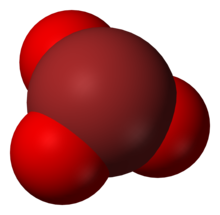Bromate
Photoactivation (sunlight exposure) will encourage liquid or gaseous bromine to generate bromate in bromide-containing water.
The following reactions will take place (via the intermediate creation of hypobromite): Bromate in drinking water is toxic because it is a suspected human carcinogen.
Bromide can be found in sufficient concentrations in fresh water to produce (after ozonation) more than 10 ppb of bromate—the maximum contaminant level established by the USEPA.
At the Silver Lake and Elysian reservoirs a combination of bromide from well water, chlorine, and sunlight had formed bromate.
[5] On June 9, 2008 the LADWP began covering the surface of the 10-acre (4 ha), 58-million-US-gallon (0.22×10^6 m3) open Ivanhoe Reservoir with black, plastic shade balls to block the sunlight which causes the naturally present bromide to react with the chlorine used in treatment.


